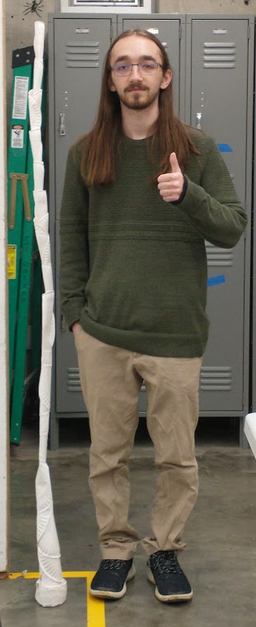
The Object is a thin, alabaster spire standing over five-and-a-half feet tall, wrought of paper plates and a single paperclip. It is slightly thicker at the bottom, and creeps haphazardly upward, precariously balanced.
Our objective was to construct a sculpture using predominately paper plates that towered up as high as we could get it. Initially I had been experimenting with right-angle folds, but soon realized that while those sorts of folds may look nice, they were not well-suited to towering upward. In my experimentation, I found that tubular folds were able to remain rigid, and could be interlocked to reach greater heights. I had begun building this off of a cone-shaped fold, which I had intended to be the top of the object, but after setting down on top of my water bottle, and realizing the stability that provided, I recognized that placing the cone-shaped end of my structure on a stout base could be the perfect way of stabilizing my structure. And thus, I made a small, sturdy base out of plates that would function to stabalize my structure. At this point I had secured the beginnings of my spire to the base, and now the only way to build was upwards. And thus, I continuously made slightly tapered tubes out of paper plates, carefully placing them into the structure I already had, hoping and praying that my spire would not collapse. As I reached higher and higher, I began to need to use smaller plates to build up higher, as larger plates would destabilize the spire too much, causing it to collapse. Eventually, I managed to extend the spire up to a little bit under six feet (a bit taller than I am), which was satisfactory for me.
It was fun creating this project because in class the race to get a sculpture higher and higher was framed as a competition of some sort, and as I can sometimes be competitive without meaning to be, it was very satisfying that my sculpture managed to be the highest one. In accomplishing this, I realized that though my sculpture was not the prettiest, nor the most structurally sound, that I had managed to reach up to a surprising height, which was good enough for me.
